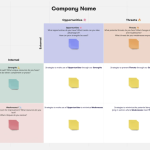Introduction
As a student, it is crucial to have a comprehensive understanding of your strengths, weaknesses, opportunities, and threats. This understanding is not just for academic purposes, but it also plays a significant role in personal and professional development. This is where SWOT analysis comes in. SWOT analysis is a strategic planning tool that helps individuals and organizations identify the internal and external factors that can impact their goals and objectives. It provides a clear picture of where you stand and what you need to work on to achieve your goals. In this article, we will discuss 5 SWOT analysis examples specifically tailored for students. These examples will cover various aspects such as personal development, career planning, academic performance, and business planning.
Understanding your SWOT is not just about listing down your strengths, weaknesses, opportunities, and threats. It’s about analyzing these factors and understanding how they interact with each other. It’s about leveraging your strengths and opportunities, improving your weaknesses, and mitigating your threats. This understanding can help you make informed decisions, set realistic goals, and develop strategies to achieve these goals.
What is SWOT Analysis?
Before we dive into the examples, let’s first understand what SWOT analysis is. SWOT stands for Strengths, Weaknesses, Opportunities, and Threats. It is a simple yet effective tool that helps individuals and organizations assess their current situation and make informed decisions. SWOT analysis can be used for personal development, career planning, and even business planning. It provides a structured way to identify and analyze the internal and external factors that can impact your goals and objectives.
SWOT analysis is not just a tool for businesses. It can be equally effective for individuals, especially students. As a student, you can use SWOT analysis to understand your academic strengths and weaknesses, identify opportunities for growth and development, and recognize potential threats to your academic and career goals. It can help you make informed decisions about your studies, career choices, and personal development.
Strengths
Strengths refer to the positive attributes or characteristics that give you an advantage over others. These can be your skills, knowledge, experience, or personal qualities. As a student, your strengths can include good time management skills, strong communication skills, or a high GPA. Identifying your strengths is important as it can help you leverage them to achieve your goals. It can also boost your confidence and motivate you to work harder.
In addition to your academic strengths, it’s also important to identify your personal strengths. These can include your personality traits, values, and attitudes that can contribute to your success. For example, being resilient, adaptable, and self-motivated are valuable strengths that can help you overcome challenges and achieve your goals. Understanding your strengths can also help you choose the right career path and make the most of your opportunities.
Weaknesses
Weaknesses are the areas where you may lack skills, knowledge, or experience. These can hinder your progress and prevent you from reaching your full potential. As a student, your weaknesses can include poor time management, lack of organization, or difficulty in public speaking. It is important to identify your weaknesses so that you can work on improving them. Recognizing your weaknesses is not about being negative or self-critical, but about being self-aware and proactive.
Working on your weaknesses can not only improve your performance but also enhance your personal growth. For example, if you struggle with public speaking, you can join a public speaking club or take a course to improve your skills. If you have poor time management skills, you can use tools and techniques to manage your time more effectively. By addressing your weaknesses, you can turn them into strengths and increase your chances of success.
Opportunities
Opportunities are external factors that can help you achieve your goals. These can be new trends, advancements in technology, or networking opportunities. As a student, opportunities can include internships, scholarships, or networking events. Identifying opportunities can help you take advantage of them and further your personal and professional growth. It can also open up new possibilities and pathways for your career.
In addition to these, opportunities can also come from changes in the external environment. For example, the increasing demand for digital skills, the growth of remote work, and the rise of entrepreneurship are all opportunities that you can leverage. By staying informed about the latest trends and developments, you can identify and seize these opportunities. Remember, opportunities are not just about what’s available, but also about how you can create and make the most of them.
Threats
Threats are external factors that can hinder your progress or pose a risk to your goals. These can include competition, economic changes, or personal challenges. As a student, threats can include financial constraints, lack of job opportunities, or personal issues. Identifying threats can help you prepare for them and minimize their impact on your goals. It can also help you develop strategies to mitigate these threats and protect your interests.
Threats can be unpredictable and beyond your control. However, by being aware of potential threats, you can be better prepared to deal with them. For example, if you are aware of the high competition for job opportunities in your field, you can work on improving your skills and gaining relevant experience to stand out from the competition. If you are facing financial constraints, you can explore scholarships, part-time jobs, or financial aid options. By proactively managing threats, you can reduce their impact and ensure your progress towards your goals.
SWOT Analysis Examples for Students
Now that we have a clear understanding of what SWOT analysis is, let’s look at 5 SWOT analysis examples for students. These examples will cover different aspects such as personal development, career planning, academic performance, and business planning. They will provide a practical guide on how to conduct a SWOT analysis and how to use it to make informed decisions and develop effective strategies.
Example 1: Personal SWOT Analysis

This example is specifically tailored for students who want to assess their personal strengths, weaknesses, opportunities, and threats. It can be used for personal development, career planning, or even for academic purposes. A personal SWOT analysis can help you understand yourself better, identify areas for improvement, and develop strategies to achieve your personal and professional goals.
Strengths
- Good time management skills
- Strong communication skills
- High GPA
- Ability to work well in a team
- Creative thinking
These strengths can give you a competitive edge in your studies, career, and personal life. They can enhance your performance, increase your productivity, and improve your relationships. By leveraging these strengths, you can achieve your goals more effectively and efficiently.
Weaknesses
- Procrastination
- Difficulty in public speaking
- Lack of organization
- Poor study habits
- Inability to handle stress
These weaknesses can hinder your progress and affect your performance. However, by recognizing and addressing these weaknesses, you can turn them into strengths. You can use strategies, tools, and resources to improve these areas and enhance your skills and abilities.
Opportunities
- Internship opportunities
- Networking events
- Study abroad programs
- Leadership roles in student organizations
- Career fairs
These opportunities can provide valuable experiences, knowledge, and connections that can boost your career and personal growth. By seizing these opportunities, you can enhance your skills, expand your network, and increase your chances of success.
Threats
- Financial constraints
- Competition for job opportunities
- Personal issues
- Changing job market
- Academic pressure
These threats can pose challenges and risks to your goals. However, by identifying and managing these threats, you can minimize their impact and protect your interests. You can develop strategies to mitigate these threats and ensure your progress towards your goals.
Example 2: Career SWOT Analysis

This example is specifically tailored for students who are about to enter the job market or are looking to switch careers. It can help you assess your strengths, weaknesses, opportunities, and threats in relation to your career goals. A career SWOT analysis can provide valuable insights into your career prospects, potential challenges, and strategies for success.
Strengths
- Relevant education and skills
- Internship or work experience
- Strong references
- Good networking skills
- Positive attitude
These strengths can enhance your employability and increase your chances of landing a job. They can also help you perform well in your job and advance in your career. By leveraging these strengths, you can stand out from the competition and achieve your career goals.
Weaknesses
- Lack of experience in a specific field
- Limited knowledge of industry trends
- Inadequate technical skills
- Poor time management
- Difficulty in adapting to change
These weaknesses can affect your job prospects and career growth. However, by recognizing and addressing these weaknesses, you can improve your skills and increase your employability. You can take courses, attend workshops, or seek mentorship to enhance your knowledge and skills.
Opportunities
- Job openings in your field of interest
- Networking events
- Professional development courses
- Industry conferences
- Mentorship programs
These opportunities can provide valuable experiences, knowledge, and connections that can boost your career. By seizing these opportunities, you can enhance your skills, expand your network, and increase your chances of landing a job or advancing in your career.
Threats
- High competition for job opportunities
- Economic changes
- Rapidly changing job market
- Personal challenges
- Limited job growth in your field
These threats can pose challenges and risks to your career goals. However, by identifying and managing these threats, you can minimize their impact and protect your career interests. You can develop strategies to mitigate these threats and ensure your progress towards your career goals.
Example 3: Academic SWOT Analysis
This example is specifically tailored for students who want to assess their academic strengths, weaknesses, opportunities, and threats. It can help you identify areas where you excel and areas where you need to improve. An academic SWOT analysis can provide valuable insights into your academic performance, potential challenges, and strategies for success.

Strengths
- Good study habits
- Strong understanding of core subjects
- High GPA
- Ability to work well under pressure
- Good time management skills
These strengths can enhance your academic performance and increase your chances of success. They can also help you excel in your studies and achieve your academic goals. By leveraging these strengths, you can maximize your academic potential and achieve excellence.
Weaknesses
- Difficulty in understanding certain subjects
- Poor time management
- Inadequate note-taking skills
- Lack of participation in class
- Procrastination
These weaknesses can affect your academic performance and hinder your progress. However, by recognizing and addressing these weaknesses, you can improve your skills and enhance your academic performance. You can use strategies, tools, and resources to improve these areas and enhance your academic skills.
Photo by Javier Trueba









